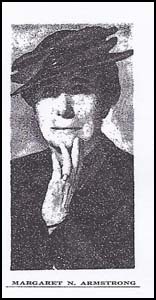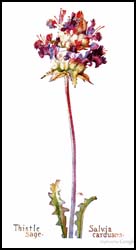 Margaret Neilson Armstrong was born in New York on September 24, 1867 into a wealthy and artistically minded family. Her father, David Maitland Armstrong had inherited land holdings along the Hudson and her mother Helen Neilson, could claim lineage to Peter Stuyvesant, who played a major role in the development of early New York. As a young girl, Margaret spent five years in Italy where her father studied oil painting and served as the Consul General to the Papal States. Margaret’s sister Helen was born while the family was in Italy and would go on to become a well-regarded stained glass artist. Margaret and Helen collaborated on projects throughout their lives beginning in their youth. After five years in Italy the Armstrong family returned to the United States and lived at the family estate, Danskammer, which was located in New York on her father’s land on the northern Hudson River.
Margaret Neilson Armstrong was born in New York on September 24, 1867 into a wealthy and artistically minded family. Her father, David Maitland Armstrong had inherited land holdings along the Hudson and her mother Helen Neilson, could claim lineage to Peter Stuyvesant, who played a major role in the development of early New York. As a young girl, Margaret spent five years in Italy where her father studied oil painting and served as the Consul General to the Papal States. Margaret’s sister Helen was born while the family was in Italy and would go on to become a well-regarded stained glass artist. Margaret and Helen collaborated on projects throughout their lives beginning in their youth. After five years in Italy the Armstrong family returned to the United States and lived at the family estate, Danskammer, which was located in New York on her father’s land on the northern Hudson River.
From 1872 to 1888, the Armstrong family lived at Danskammer, whose wooded surroundings likely formed Margaret’s fascination with natural motifs in her later design work. According to Margaret’s brother, Hamilton Fish Armstrong, “Margaret and Helen were remarkable women. As Margaret was older she got her start as an artist first, to be exact at age sixteen, when she began painting dinner cards and menus.” Helen soon followed even though neither sister had much formal training in art. In 1890, Margaret’s first book cover was published in Chicago by the firm, A.C. McClurg. Margaret and Helen’s first publicly recognized collaboration was the design for Marguerite Bouvet in her novel Sweet William which was credited to them by name on the title page. This was an accomplishments as the decorative arts at the turn of the century were still considered a man’s field. Oftentimes, this influenced Margaret to use the name M.N. Armstrong when submitting her sample works. Despite the difficulties for women in the design field, in 1892, the Armstrong sisters’ work was featured in the Women’s Building of the World’s Colombian Exposition in Chicago and both won awards in their field. The success of the artists featured in the Women’s Building opened opportunities for women in the field of art and design. Margaret would continue on to spearhead the role of a talented cover designer in her field.
 Margaret Armstrong is best known for her designs on dark blue cloth for the Henry Van Dyke books. This collection was planned as a series and is considered on of Armstrong’s most impressive achievements. Beginning with Little Rivers in 1895 and completed with Companionable Books in 1926, this collection is an example of the quintessential Armstrong style of bold natural motifs and symmetrical designs in gold leaf.
Margaret Armstrong is best known for her designs on dark blue cloth for the Henry Van Dyke books. This collection was planned as a series and is considered on of Armstrong’s most impressive achievements. Beginning with Little Rivers in 1895 and completed with Companionable Books in 1926, this collection is an example of the quintessential Armstrong style of bold natural motifs and symmetrical designs in gold leaf.
Armstrong’s other most identifiable collection of work are the covers for Myrtle Reed which feature lavender cloth and brightly colored inks. Spanning the years of 1899 to 1913, this collection stood out for its unconventionally light color and feminine design features.
There are over 270 covers that have been attributed to Armstrong over her design career and many stand on their own as exceptional works of art. Between the years of 1908 to 1913, Armstrong was designing as few as five covers per year. This coincided with her newest project of assembling a book of wildflowers of the western United States. In 1915, Armstrong completed The Field Book of Western Wildflowers which was meant to be the first “popular field book for the whole West.”
Upon completion of the field book, Armstrong began to edit and design works for her father and brother as well as contribute regularly to noteworthy magazines of the time. In her sixties, Margaret wrote two biographies and in her seventies, she wrote three successful mystery novels. Margaret Neilson Armstrong passed away on July 18, 1944 in New York. Her life was one of varied accomplishments. She was a designer, editor, botanist, adventurer and author who seemed to tackled each new project with tenacity and passion. Her art remains a testament to her skill as an innovative and bold designer.


